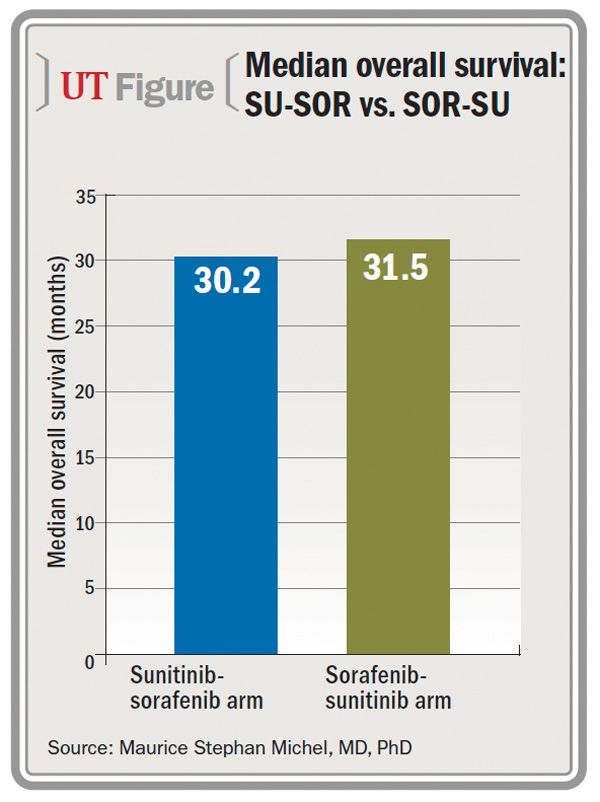Article
Sequential therapies for metastatic renal cell carcinoma yield similar results
Author(s):
The sequential use of two targeted treatments for metastatic renal cell carcinoma appears to yield similar total progression-free survival regardless of the order in which they are given, phase III study results indicate.
San Francisco-The sequential use of two targeted treatments for metastatic renal cell carcinoma (mRCC) appears to yield similar total progression-free survival (PFS) regardless of the order in which they are given, phase III study results indicate.
Although there are now several good treatments for mRCC, patients eventually progress on first-line therapy and require second-line treatment. The SWITCH trial attempted to determine whether sequencing with sunitinib (Sutent) as first-line therapy and switching to sorafenib (Nexavar) (SU-SOR) at disease progression or vice versa (SOR-SU) achieves superior outcomes. The primary endpoint was total PFS.
Results showed that both sequences achieved comparable overall survival benefit, and neither was superior.
“Both sequences provided overall treatment benefit in metastatic renal cell carcinoma. The primary objective of this trial was not met because neither sequence achieved superior total progression-free survival. Overall survival was similar in both arms. Safety profiles were as expected,” said lead author Maurice Stephan Michel, MD, PhD, medical director of urology at University Hospital Mannheim, University of Heidelberg, Mannheim, Germany.

Dr. Michel presented results of SWITCH at the Genitourinary Cancers Symposium in San Francisco.
SWITCH was an open-label, multicenter, phase III study that randomized 365 patients with mRCC in a 1:1 ratio to either SU-SOR or SOR-SU. Patients were treated until disease progression with first-line therapy and then moved on to second-line therapy at progression.
Patient demographics and disease characteristics were comparable between the two treatment arms. Most patients were intermediate risk according to Memorial Sloan-Kettering Cancer Center criteria.
Ninety-seven percent of patients received first-line therapy in the SOR-SU arm and 96% in the SU-SOR arm; at the end of the study, 11% were still on first-line sunitinib and 9% on first-line sorafenib.
Second-line therapy was delivered to 42% of the SU-SOR patients and 57% of the SOR-SU patients. At the end of the study, 3% and 7%, respectively, were still on second-line therapy.
Continue to next page for more.
No difference in PFS seen between arms
No difference was observed between the two treatment arms for the primary endpoint of total PFS, defined as time from randomization to confirmed progression or death during second-line therapy. Median total PFS was 14.9 months for SU-SOR and 12.5 months for SOR-SU, with a hazard ratio (HR) of 1.01 (95% confidence interval: <1.27).
Overall survival was also no different: median of 30.2 months for SU-SOR and 31.5 months for SOR-SU (HR: 1, 95% CI: <1.30).
Dr. Michel called the overall survival of over 30 months “remarkable” in mRCC.
“This is among the longest survival reported in metastatic renal cell carcinoma,” he said.
An analysis evaluating second-line median total PFS found a significant difference favoring the SOR-SU arm: 5.4 months versus 2.8 months (HR: 0.55; p<.001). Dr. Michel said that this finding should be viewed cautiously due to imbalances between the two arms in the numbers of patients who reached second-line therapy.
Side effects after first-line therapy differed in the two arms, reflecting differences between the two drugs. Treatment-emergent diarrhea and skin reactions were more common when sorafenib was used as first line, whereas nausea and stomatitis were more common with first-line sunitinib.
Treatment-emergent adverse events were less frequent with second-line therapy for both drugs. Dr. Michel attributed this to the fact that patients who got to second-line therapy were fitter than those who failed to reach second line.
Dr. Michel has received honoraria from Astellas Pharma, Bayer, and Novartis, and several of his co-authors have served as consultants/advisers and/or have received honoraria from Bayer and/or Pfizer.UT
Like this article? Check out these other recent Urology Times articles:
Robotic nephrectomy on the rise, but why?
Robotic partial nephrectomy: Renal function loss low in CKD patients
Primary ADT for prostate cancer shows no survival benefit
Subscribe to Urology Times to get monthly news from the leading news source for urologists.
Newsletter
Stay current with the latest urology news and practice-changing insights — sign up now for the essential updates every urologist needs.

















